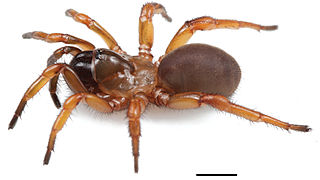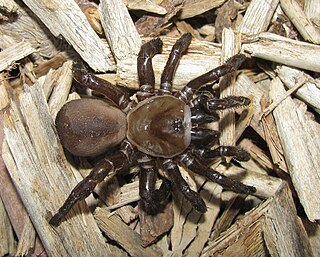
Hadronyche formidabilis, the northern tree-dwelling funnel-web spider, is a highly venomous mygalomorph spider found in Queensland and New South Wales. It is also known as the Northern Rivers funnel-web spider or northern funnel-web spider.
Cyriopagopus hainanus is a species of spider in the family Theraphosidae (tarantulas), found in China. It is one of a number of species from China and Vietnam known as "Chinese bird spider". It produces a venom containing numerous compounds capable of blocking neurotransmitters, including neurotoxic peptides called hainantoxins.

Cyriopagopus schmidti is a species of spider in the family Theraphosidae (tarantulas), found in China and Vietnam. It is one of a number of species known as "Chinese bird spider" and "Chinese earth tiger". Haplopelma huwenum was synonymized with this species in 2008. Spiders under this name and its synonyms have been shown to produce toxins called huwentoxins.
Nihoa is a genus of South Pacific brushed trapdoor spiders first described by Tracey Churchill & Robert Raven in 1992. It is named after the island Nihoa, where the type species is endemic.

Barychelidae, also known as brushed trapdoor spiders, is a spider family with about 300 species in 42 genera. Most spiders in this family build trapdoor burrows. For example, the 20 millimetres (0.79 in) long Sipalolasma builds its burrow in rotted wood, with a hinged trapdoor at each end. The 10 millimetres (0.39 in) long Idioctis builds its burrow approximately 5 centimetres (2.0 in) deep, just below the high tide level, sealing the opening with a thin trapdoor.

Sason is a genus of bark-dwelling brushed trapdoor spiders first described by Eugène Simon in 1887. It is distributed from the Seychelles through India to northern Australia. The closest related genus seems to be the monotypic Paracenobiopelma.

Unicorn ("one horn", in Latin) is a genus of goblin spiders from South America, containing seven species that occur predominantly in high elevation, semi-desert regions of Bolivia, Chile, and Argentina. Individuals are relatively large for goblin spiders, measuring up to 3.0 mm (0.12 in) in body length. The genus name refers to a characteristic pointed projection between the eyes and jaws of males. In at least one species, broken-off tips of the male pedipalps have been found within the genitalia of females, postulated as a means of sperm competition. Unicorn possesses several traits that suggest it is a relatively "primitive" member of the Oonopidae, and is classified with other similar, soft-bodied goblin spiders in the subfamily Sulsulinae.

Myrmekiaphila is a genus of North American mygalomorph trapdoor spiders in the family Euctenizidae, and was first described by G. F. Atkinson in 1886. All described species are endemic to the southeastern United States.

Heteropoda davidbowie is a species of huntsman spider of the genus Heteropoda. It was described from the Cameron Highlands District in peninsular Malaysia and named in honour of singer David Bowie.
Pimoa cthulhu is a species of the spider family Pimoidae. It is one of twenty-one described species in the genus Pimoa.

Portia schultzi is a jumping spider which ranges from South Africa in the south to Kenya in the north, and also is found in West Africa and Madagascar. In this species, which is slightly smaller than some other species of the genus Portia, the bodies of females are 5 to 7 mm long, while those of males are 4 to 6 mm long. The carapaces of both sexes are orange-brown with dark brown mottling, and covered with dark brown and whitish hairs lying over the surface. Males have white tufts on their thoraces and a broad white band above the bases of the legs, and these features are less conspicuous in females. Both sexes have tufts of orange to dark orange above the eyes, which are fringed with pale orange hairs. Males' abdomens are yellow-orange to orange-brown with blackish mottling, and on the upper sides are black and light orange hairs, and nine white tufts. Those of females are pale yellow and have black markings with scattered white and orange-brown hairs on the upper side. P. schultzi has relatively longer legs than other Portia, and a "lolloping" gait.
Lycinus quilicura is a mygalomorph spider of Chile, named after its type locality: Quilicura, Región Metropolitana. The species is distinguished from others in the genus by its distinctly long embolus.

Cyriopagopus is a genus of southeast Asian tarantulas found from Myanmar to the Philippines. As of March 2017, the genus includes species formerly placed in Haplopelma. It was first described by Eugène Louis Simon in 1887.
Anelosimus oritoyacu is a species of tangle-web spider found in Ecuador and Mexico at altitudes from 1,800 to 2,000 metres. It is subsocial, although it has some features which distinguish it from other social or subsocial spiders in the genus. It has long-lived nest sites, unlike the social spider Anelosimus eximius which has more transitory nest sites, and its webs do not have aerial threads found in other social and sub-social species. It has a female-biased sex ratio, which is indicative of social behavior, although its sex ratio is smaller than other social species. It was first identified as distinct from Anelosimus studiosus in 2006 by Ingi Agnarsson. It is named for Oritoyacu, Ecuador, where the type specimen was collected.

Eucteniza is a genus of trapdoor spiders in the family Euctenizidae containing at least 14 species occurring in Mexico and the southern United States. Species are distinguished by a softened rear portion of the carapace, and males possess large spines on the first two pairs of walking legs that are used to hold females during mating. Like other trapdoor spiders they create burrows with a hinged lid, from which they await passing insects and other arthropods to prey upon. Many species are known from only one or two localities, or from only male specimens. More species are expected to be discovered. Eucteniza is closely related to spiders of the genera Entychides and Neoapachella.
Sason hirsutum is a species of spiders in the family Barychelidae, found in Indonesia.
Inthaeron is a monotypic genus of Asian araneomorph spiders in the family Cithaeronidae, containing the single species, Inthaeron rossi. It was first described by Norman I. Platnick in 1991, and has only been found in India. Females can be distinguished from those of its sister genus, Cithaeron, by the arrangement of cylindrical gland spigots on the posterior median spinnerets, appearing in two rows rather than in clusters. The name is derived from "India", the country it was first found in, and "Cithaeron", the name of the other genus of Cithaeronidae.
Augacephalus breyeri is a species of harpactirine theraphosid spider, found in South Africa, Mozambique and Swaziland.
Tliltocatl andrewi is a possible species of spider in the family Theraphosidae (tarantulas). The World Spider Catalog regards it as a nomen dubium. Only the male has been described and its distribution is unknown.

Halonoproctidae is a family of mygalomorph spiders, split off from the family Ctenizidae in 2018. Species in the family are widely distributed in North and Central America, Australasia, Asia, southern Europe and North Africa. One species is recorded from Venezuela in South America. They are relatively large, sombrely coloured spiders, that live in burrows with some kind of trapdoor.









